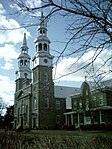Papineau-Leblanc Bridge

The Papineau-Leblanc Bridge was one of the first cable-stayed spans in North America. It is part of Quebec Autoroute 19 and is one of the connections between Laval and Montreal, Quebec, Canada, spanning Rivière des Prairies. It was fabricated from weathering steel and has an orthotropic deck. The freeway ends abruptly at the southern end of the bridge at the intersection of Henri Bourassa Boulevard, where Autoroute 19 follows Avenue Papineau down to Quebec Autoroute 40. The Leblanc portion of the name comes from the name of a street in Laval that was expropriated to build the autoroute. That street was named after Alpha Leblanc, a local landowner. Portions of that street remain on both sides of the autoroute. In 2000, a proposition to rename the bridge after the late Pietro Rizzuto was initially approved, then rejected by the Commission de Toponymie du Québec, which ruled that the name Papineau-Leblanc was already entrenched in local culture and non-controversial. Most locals simply refer to this bridge as Papineau.
Excerpt from the Wikipedia article Papineau-Leblanc Bridge (License: CC BY-SA 3.0, Authors, Images).Papineau-Leblanc Bridge
Pont Papineau-Leblanc, Laval Duvernay
Geographical coordinates (GPS) Address Nearby Places Show on map
Geographical coordinates (GPS)
| Latitude | Longitude |
|---|---|
| N 45.576 ° | E -73.6666 ° |
Address
Pont Papineau-Leblanc
Pont Papineau-Leblanc
H2B 1W9 Laval, Duvernay
Quebec, Canada
Open on Google Maps






